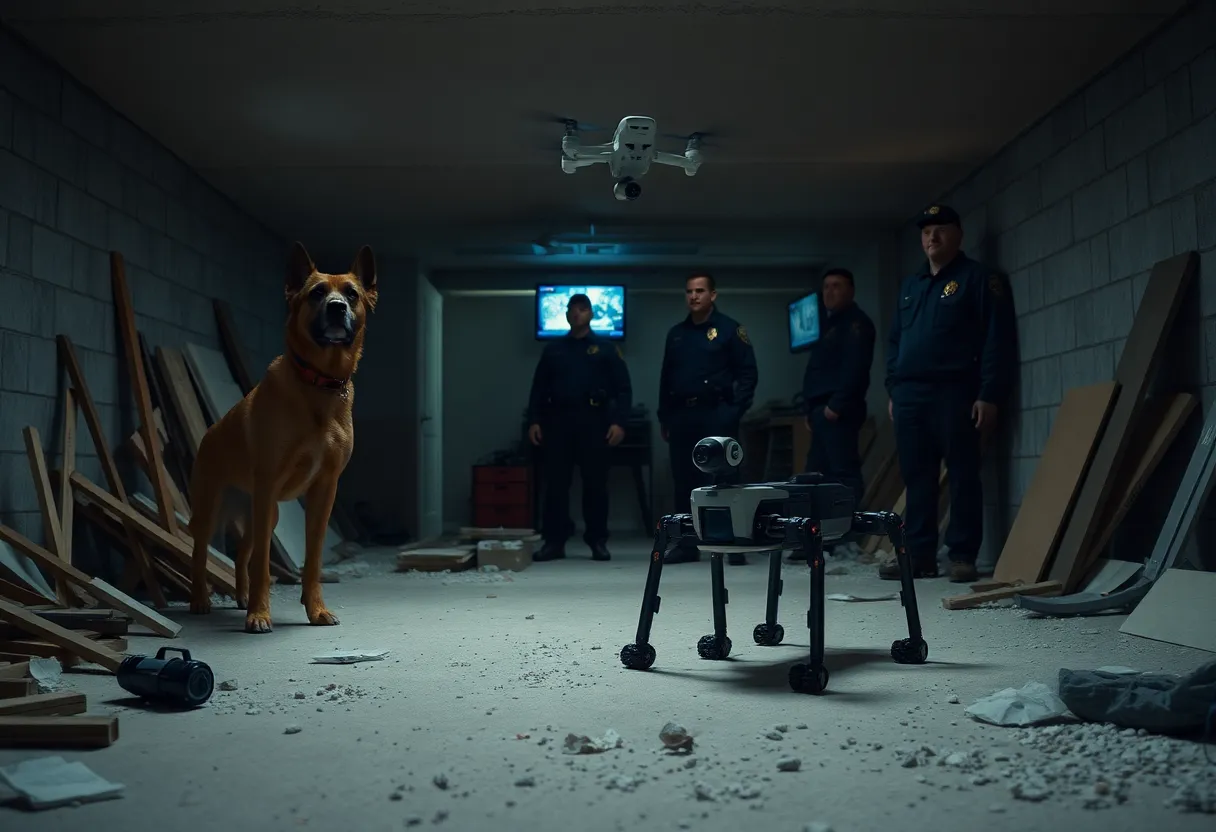Enfield, Connecticut, August 25, 2025
News Summary
A suspected burglar hiding inside a Garden Street home in Enfield, Connecticut, was found and arrested after a police K-9 completed a building search. Officers first used aerial drones to sweep floors but could not locate the subject; K-9 Dunkin, a German shepherd, cleared multiple levels and located the suspect hiding under basement construction debris. The response highlighted the department’s recent purchase of a four-legged robotic unit, R3KO, added to its UAV program to inspect confined or obstructed indoor spaces where aerial drones have limitations. The robot provides live camera feeds, can carry small payloads and is operated by trained officers to enhance officer and public safety.
Enfield K-9 Dunkin Apprehends Burglary Suspect; Department Adds R3KO/Rico Robotic Dog to Drone Program
Summary
Police responded to an active burglary at a residence on Garden Street after a homeowner reported seeing a man force entry. Video cameras captured the intruder inside the house. The department activated its Drone and K‑9 Unit, set a perimeter, and used an aerial drone to clear each floor. When the drone team did not locate the suspect, a three‑year‑old German shepherd named K-9 Dunkin conducted a building search. After clearing multiple floors and discovering a broken basement window, officers made repeated announcements. With no response, the K‑9 entered the basement and found the suspect hiding under construction debris. The subject was apprehended without injuries to officers or the subject.
Topline details
The response combined aerial and ground assets. An aerial drone was used first to check floors but could not find the individual inside. The department then relied on the canine unit, which located the suspect in the basement after officers noticed basement damage and made announcements. A perimeter was maintained by the Drone and K‑9 Unit throughout the response.
Why the department bought a robotic dog
The department maintains an active UAV/aerial drone program that has been used for missing persons, Alzheimer’s and dementia searches, and for improving officer safety. After an earlier incident revealed limits of aerial drones in indoor and building‑entry situations, the department reallocated funds from the UAV program budget to purchase a four‑legged robotic drone, spelled R3KO and pronounced Rico. The purchase price was reported in different accounts as roughly $4,700 and as just shy of $4,800, approximately the same cost as a traditional aerial drone.
What the robotic dog can do
The robotic unit is designed to mimic a dog’s shape and movement to provide comfort and to blend familiar form with functionality. From a distance it looks smaller than a working police dog; up close it appears thin and mechanical with visible wires and metal. It walks, sprints, sits, jumps, can walk on two legs and perform a handstand, and its joints move in a way that goes beyond typical canine motion. It has a small head-mounted camera as an appendage that supplies live visuals to operators.
The robotic dog can navigate stairs, pass through doorways, move through partially closed doors, curtains, and draperies, and search areas where aerial drones could not safely go without crashing. It can carry a small payload — for example, a cell phone — so officers can establish communication with someone who is barricaded or otherwise isolated. Trained officers control the robot.
Operational use and limits
The robot had been operational for about a week at the time of reporting and was already used in a home burglary response. In that incident, the robotic dog searched parts of the house and helped confirm that certain areas were safe. The robot did not locate the suspect hiding under basement debris; that subject was ultimately found and apprehended by the department’s real K‑9 unit without injuries. The department views the robotic dog as an added life‑safety and officer‑safety tool rather than a replacement for living K‑9s or traditional tactics.
Policy and purpose
The decision to add the robotic dog followed a formal review of the UAV program budget and a reassessment of equipment needs after a prior incident with “touch and go” moments that highlighted limitations of aerial drones indoors. The robotic dog is intended to enhance officer safety, subject safety, and public safety by putting visual sensors into spaces that are difficult or risky for people and for aerial drones to access.
Other recent K‑9 activity
Besides the Garden Street burglary response, the K‑9 unit has been used in other local enforcement actions. On one recent call, a tracking effort led officers to a commercial location where a K‑9 alerted to a person hiding; that person was taken into custody without further reported details in the initial accounts.
What to expect going forward
The department plans to keep the robotic dog as part of its UAV and drone lineup and to continue using aerial drones and trained canines together as complementary tools. The robotic unit adds capabilities where aerial drones face mechanical limits and where human entry would present greater risk. The department emphasizes measurement of safety outcomes and continued training for officers who operate the new technology.
Frequently Asked Questions
What happened at the Garden Street residence?
The homeowner reported a man forcing entry. Cameras showed the intruder inside, prompting a response by the Drone and K‑9 Unit. Aerial drone searches of floors did not locate the person; the department’s K‑9 entered the basement after officers found a broken window and located the suspect under construction debris.
Was anyone hurt during the arrest?
No injuries were reported to officers or to the person who was apprehended.
What is R3KO/Rico and why was it purchased?
R3KO is a four‑legged robotic drone added to the department’s UAV lineup to overcome indoor limitations of aerial drones and to improve officer, subject, and public safety. The unit can go through partially closed doors and drapes, climb stairs, and provide live camera views.
How much did the robotic dog cost and how was it funded?
Reported purchase amounts were approximately $4,700 and just under $4,800. The department used existing UAV/drone program funds to acquire the robot.
Does the robotic dog replace live K‑9s?
No. The robotic dog is an additional tool to provide remote visuals and access in risky areas. Trained living K‑9s remain essential for tracking, detection, and suspect apprehension.
Who controls the robotic dog?
Trained officers operate the robot remotely as part of the department’s Drone and K‑9 Unit.
Key Features at a Glance
| Feature | Details |
|---|---|
| K-9 Dunkin | 3-year-old German shepherd used to clear building; located suspect hiding under basement debris; no injuries reported. |
| R3KO/Rico | Four-legged robotic drone added to UAV lineup; pronounced “Rico”; dog-like shape with camera head; controlled by trained officers. |
| Capabilities | Can walk, sprint, sit, jump, climb stairs, pass through doorways, move through partially closed doors/curtains, carry small payloads (e.g., phone). |
| Primary uses | Provide visuals in spaces aerial drones cannot safely access; improve officer, subject, and public safety during building searches and barricade situations. |
| Funding and cost | Purchased from existing UAV/drone program funds; reported cost roughly $4,700 to just under $4,800. |
| Operational history | Operational for about a week at time of reporting; used in a home burglary call to clear areas though the real K-9 ultimately found the suspect. |
Deeper Dive: News & Info About This Topic
Additional Resources
- FOX61: Enfield police purchase robot K-9 unit
- Wikipedia: Quadruped robot
- CT Insider / Journal Inquirer: Enfield drone dog/robot police
- Google Search: Enfield R3KO robotic dog
- Patch: Enfield police dog locates burglary suspect
- Google Scholar: police K-9 building search
- WWLP: Enfield police use drone and K-9 to capture burglary suspect
- Encyclopaedia Britannica: police dog
- WFSB: K9 Dunkin helps track down fleeing suspect near Enfield Commons
- Google News: Enfield K-9 Dunkin
Author: Construction CA News
The CALIFORNIA STAFF WRITER represents the experienced team at constructioncanews.com, your go-to source for actionable local news and information in California and beyond. Specializing in "news you can use," we cover essential topics like product reviews for personal and business needs, local business directories, politics, real estate trends, neighborhood insights, and state news affecting the area—with deep expertise drawn from years of dedicated reporting and strong community input, including local press releases and business updates. We deliver top reporting on high-value events such as the Rose Parade, Coachella, Comic-Con, and the California State Fair. Our coverage extends to key organizations like the California Building Industry Association and Associated General Contractors of California, plus leading businesses in technology and entertainment that power the local economy such as Apple and Alphabet. As part of the broader network, including constructionnynews.com, constructiontxnews.com, and constructionflnews.com, we provide comprehensive, credible insights into the dynamic landscape across multiple states.




